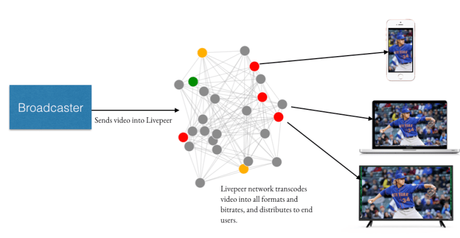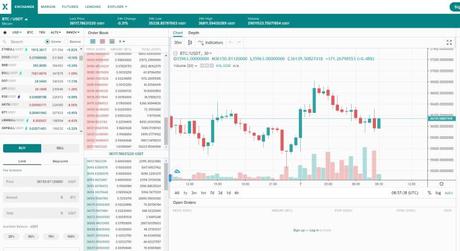By leveraging technology, Livepeer builds tools for streaming live video on the Internet. Global communication and information sharing have become increasingly dependent on video. In January 2021, over 2 billion hours of video streaming had been consumed on the Twitch platform, showing that nearly 80% of internet users have a YouTube account.
I haven’t even begun to mention the critical role that real-time video platforms like Zoom, Telegram, or Google Meet play. Although all of this sounds great, there are still issues with these centralized services having excessive control over their user bases, their data, and their ability to censor what they like.
The proposed video streaming applications that compete with centralized video streaming remain impossible to build in 2021. Despite technological advancements, the cost of transcoding live streaming video remains high, given that transcoding is a very computationally intensive process.

Transcoding occurs whenever a video service provides video to end-users, which takes the video and recodes it into a format the end-user can consume. Transcoding of video in present times is mainly performed by centralized cloud services such as Amazon Web Services and Microsoft’s Azure, which presents a significant point in the video delivery snafu.
Decentralized video streaming services have become increasingly popular in recent years; however, none of them have the capability to stream video in an open way. The availability of decentralized transcoding would allow the creation of services that would provide cheaper, more stable, and scalable live video streaming. Decentralizing the transcoding process would result in censor-resistant and developer-friendly transcoding.
What is a Livepeer Token (LPT)?
Livepeer is a decentralized open-source protocol for video and lives streaming infrastructure, which runs on the Ethereum blockchain.
The Livepeer network can be used as a platform for hardware providers to provide video infrastructure services to others who require such services, such as those that require live streaming applications (such as PlayDJ.tv).
Video transcoding is currently available through the Livepeer network. In this way, video inputs in one resolution and bitrate are converted into other resolutions and bitrates, ensuring that users regardless of their connection speeds can enjoy the content. The process you go through in this step is what allows you to choose a different video quality on websites like YouTube or Twitch. tv.

Over the past couple of years, the vision of a decentralized web has begun to come true with the emergence of networks like Ethereum to enable decentralized computing, Swarm, IPFS/Filecoin to support decentralized content distribution and storage, as well as Bitcoin and other peer-to-peer key exchanges to facilitate value transfers and Blockstack and ENS to give names and labels to content.
Decentralized applications (DApps) are built upon the foundation of these elements as mostly static or rarely updated web or mobile content, but they do not provide a way to include streaming media and data that is both open and decentralized. Decentralizing telecasts over the Internet via live video is the aim of this Livepeer project.
Live video broadcasts are currently;
- Growing rapidly in a variety of categories, such as social, events, IoT, and enterprise. The proliferation of VR and 4K and the low cost of high-quality devices with cameras are likely to accelerate this trend.
- A centralized system. The majority of live transmissions over the internet are handled by server-based media servers, which are subsequently dispersed via CDNs. It is conceivable to perform a live broadcast to more than a few of clients using WebRTC, but then again the network and bandwidth requirements for streaming are exorbitant.
- Cost-Effective. In some cases, a software license for a professional media server runs upward of $4500 and a cloud instance of the same can cost upward of $500 per month to run. Even more, can be spent on cloud computing services. A publisher that needs to run one broadcast for a few hours must acquire a big share of all existing CDNs to only air his package.
The Following 4 Components Can Be Found As Part of The Livepeer Project:
-
The Livepeer Media Server
Livepeer Media Servers are open source media servers capable of transcoding live video and audio input streams into alternative encodings, encoding them into different bitrates, and converting them into different delivery formats.
In this way, a video recorded in one format and bitrate will now play on every screen on every device, regardless of platform or format requirements. It is clear that the market is crowded with media server solutions, but most of them are proprietary, developed, and sold by one company, do not come with an open-source license, and cost a lot of money. It is hard to use all the features of open source software as it is often incomplete, out of date, unsupported or requires upgrading to proprietary service packages.
As a core component of a technology basis for developing a protocol and network that are economically efficient (see following sections), LivePeer Media Server will be financed from the protocol itself. It will thus be fully open source and transparent, and, as a result, benefit from community contributions such as peer review and open dialog about bugs and improvements.
Anyone can use the media server as a standalone component in any media streaming application. Livepeer uses the server’s maximum power when it is running as part of the network.
-
The Livepeer Network
The Livepeer Network consists of a series of Livepeer Media Servers nodes that communicate using the Livepeer Protocol. The two most common forms of network requests are publishing a stream and requesting a stream. The phrase publishing stream refers to the process of transcoding a live video with specified settings and providing the resultant clip. In a Request stream, Users seek to connect to an existing live broadcast on the network.
Streams released to the network are transcoded into any format requested by the node, and the network expands to accommodate the number of nodes requesting the stream.
According to a Kademlia-influenced protocol, nodes will manage their peer groups autonomously. Streams are sent with little delay throughout the network by assessing each node’s transmission delay and bandwidth capabilities. Nodes that have not yet consumed a stream may opt to forward the request to another node that is currently utilizing it, or they may become a relay node, utilizing the stream to pass it forward to succeeding nodes. Transcoding and verification jobs will be routed in accordance with the protocol for requesting streams from the relevant node and sending transcoding requests to the relevant node.
-
The Livepeer Token
Those who want to perform work on the Livepeer network will be able to stake the Livepeer Token, specifically because it can operate on the following:
- It is used as an anchoring mechanism by delegated proof of the stakes system, where stakes are assigned to transcoders involved in video transcoding and validation activities. A delegated proof of stake system uses it as an anchoring mechanism, where stakes are delegated to transcoders who participate in transcoding video and validating work.
This token, together with any slicing caused by a breach of the protocol, protects the network from a wide variety of threats. - The routes work via the network in accordance with the quantity of token that is staked and delegated.
- Serves as Livepeer Ecosystem’s Unit of Account.
This is a hypothetical unit of account that creates a framework for the SectorCoin conception, which has the potential to be used for advanced features.
The Livepeer ecosystem may be utilized for a broad range of services such as DVR, closed captioning, advertising insertion/monetization, and analysis. Staking LPT offers a new security layer.
-
The Livepeer Protocol
Livepeer’s protocol specification describes the roles played in the Livepeer Network, the transaction methods available, as well as the mechanisms for token distribution and cryptoeconomic security.
Livepeer Works In What Way?
Livepeer depends on a set of users that are called “orchestrators” to fulfill the standards for transcoding applications from developers in the network.
A number of these individuals participate in the Livepeer network, where they exchange their computing resources including CPU, GPU, and bandwidth for LPT, the cryptocurrency that underpins the network. With reference to cryptocurrency mining, these users are also referred to as “video miners”.
The Livepeer network requires that developers paying for distribution and transcoding services use LPT tokens. Alternatively, an LPT holder may stake or delegate their tokens, thereby gaining a yield for the tokens they hold and also contributing to network security without having to provide the computing resources necessary to deal with the transcoding.
As a result of Livepeer’s incentive program, it hopes to create a decentralized network offering in-home transcoding and video sharing that is inexpensive and censorship-resistant. Throughout the entire process, the native cryptocurrency LPT powers the incentives.
Livepeer cannot only transcode video but can also deliver video to end-users. Livepeer can handle this function just as effectively and at a lower cost as a centralized content delivery network like Cloudflare.
Defining Roles
Broadcasters: Broadcasters are responsible for publishing video streams to orchestrators and paying them in ETH.
Delegators: The LPT token is staked by this group via an orchestrator. Typically, a delegator has no desire or ability to participate as an orchestrator in a network. Rather than striving to have an ability, they delegate their tokens to existing orchestrators in exchange for a share of the profits.
Transcoders: In transcoders, orchestrators take input video and convert it into suitable formats before it is emitted.. It is possible to run multiple transcoders with an orchestrator.
Orchestrators: Orchestrators are responsible for transcoding videos into their desired output formats. A broadcaster pays them in ETH, and Livepeer rewards them with newly minted LPT tokens. Orchestrator nodes must install software that enables them to contribute computational resources to the network. Orchestrators are also obliged to put LPT tokens as collateral to ensure that they accomplish legitimate jobs and behave properly. If an orchestrator cheats or behaves inappropriately, their stake will be reduced as a result.
Using LivePeer in The Real World
Livepeer is a useful solution for anyone who is streaming video and has to transcode it. Livepeer provides a multitude of use cases, including Pay-As-You-Go Content Consumption, in addition to low-cost transcoding. A 50 fold reduction in transcoding costs is necessary to achieve all of these goals. A $50 billion market is already underway for live streaming, and Livepeer believes that it can be an integral part of it.
You can imagine the importance of live streaming in light of the fact that Amazon purchased Twitch for $970 million in cashback in 2014. While Livepeer is small now, it is gaining momentum as more streaming providers develop interest and test the service.
Livepeer has the advantage of being able to grow quickly whenever demand grows by leveraging network incentives. The network encourages users to use whatever free tools accessible to them to transcode videos.
With this alone, centralized services will be able to resolve a huge challenge, since one of the most significant challenges has always been providing an infrastructure large enough to serve an increasing number of streaming movies.
Pay-As-You-Go Consumption of Content
As the protocol is designed to facilitate a transfer of value transaction, broadcasters are now able to charge viewers for watching their live broadcasts, without requiring them to provide credit cards or accounts, and without compromising user security. Among the applications of this technology are education (paid online courses), events, entertainment (paying for a live stream of a gamer or performer), etc., while maintaining viewer’s privacy, so they pay for only what they consume.
Livepeer’s Unique Features
The Cost of Streaming video is an expense that limits app developers. While you may not realize it, when viewing videos you must pay for the video’s transmission. Video streaming costs for centralized services are typically passed along to consumers through advertising, the sale of their personal data, or through subscription costs or service fees.
Livepeer minimizes these costs by utilizing a distributed, decentralized network, enabling the development of new types of video-related applications, which will ultimately lead to new video business models. Likewise, the end-user now earns money by providing computing power, as opposed to paying the centralized services for video services.
Team LivePeer
Unlike proprietary technologies, Livepeer is an open-source project. As such, Livepeer can’t be endorsed by anyone with authority. Considering that, Members of Livepeer, Inc., and Basement. Studio is responsible for the Livepeer.org website.
Livepeer is now administered by Livepeer, Inc, the group that created and distributed the protocol. Eventually, a completely community-governed project will be established. Thus, Doug Petkanics and Eric Tang founded Livepeer.

Founder and CEO of Livepeer Inc., Doug Petkanics. In 2016, he founded Livepeer after having been Vice President of Engineering for Wildcard Inc, a mobile web browser and native publishing platform. In February 2012, Groupon acquired Hyperpublic, a data platform that organizes local information around the world, with which he was a co-founder.
Eric and Doug became interested in crypto because of Ethereum in 2016. As a result, they participated in the development of the non-fungible, token standard used today for NFTs, which is built on Ethereum’s non-fungible standard.
It became evident to Doug and Eric that Ethereum did not have a decentralized video platform. Considering their extensive experience in infrastructure engineering and their interest in video technologies, they decided to take the plunge.
In an interview Doug gave recently, he said the focus on startups stems from the fact that he and Eric have experienced the high costs associated with video streaming. Since video giants like YouTube and Twitch are already so dominant, high costs effectively make it impossible for startups to compete.
The CTO of Livepeer Inc. is Eric Tang. In addition to being a lead developer with Hyperpublic, he was also a co-founder of Wildcard Inc. He holds degrees in Electrical and Computer Engineering, Computer Science, and Business Administration from Carnegie Mellon University.
Tokenomics And The LPT ICO
An LPT token is an ERC20 token used for staking on Livepeer by orchestrators and delegations. LPT voting is done through the Livepeer Explorer, which is also used to govern the Livepeer protocol. Initial supplies of LPT totaled 10 million units. In the beginning, just over 12% of this supply went to Livepeer’s team and founders, and 5% went into a project reserve. Over two token sales in 2017, 19% of the tokens were sold to private investors, raising just under $4 million. For the first sale, the LPT sold for 94 cents, and for the second sale, it went for a hefty three dollars.
Where and How to Buy Livepeer (LPT)
Unlike other main cryptocurrencies, LPT cannot be purchased directly with fiat money, although it has been listed on several crypto exchanges. Nonetheless, it is still possible to purchase this coin by first purchasing Bitcoin, ETH, or USDT from any major exchange, and then transferring those funds to the exchange that offers it.
This will be done using Poloniex Exchange, one of the largest crypto exchanges accepting deposits in fiat currencies.
Following the confirmation of your deposit, you can then purchase LPT from the Poloniex exchange. At the moment, Poloniex, CITEX, CoinBene, Gate.io, Uniswap (V2), MXC.COM, and Binance are the most popular exchanges for Livepeer.

Learn More About LPT
☞ Website ☞ Protocol Explorer ☞ Explorer 2 ☞ Explorer 3 ☞ Explorer 4 ☞ Whitepaper ☞ Source Code ☞ Social Channel ☞ Social Channel 2 ☞ Social Channel 3 ☞ Social Channel 4 ☞ Social Channel 5 ☞ Coinmarketcap
Summary
Livepeer’s capacity to attract interest and then grow in order to meet demand will most likely give it the edge in determining whether it succeeds. Ultimately, Livepeer will be successful if it provides services comparable to those of the current centralized solutions without increasing costs.
